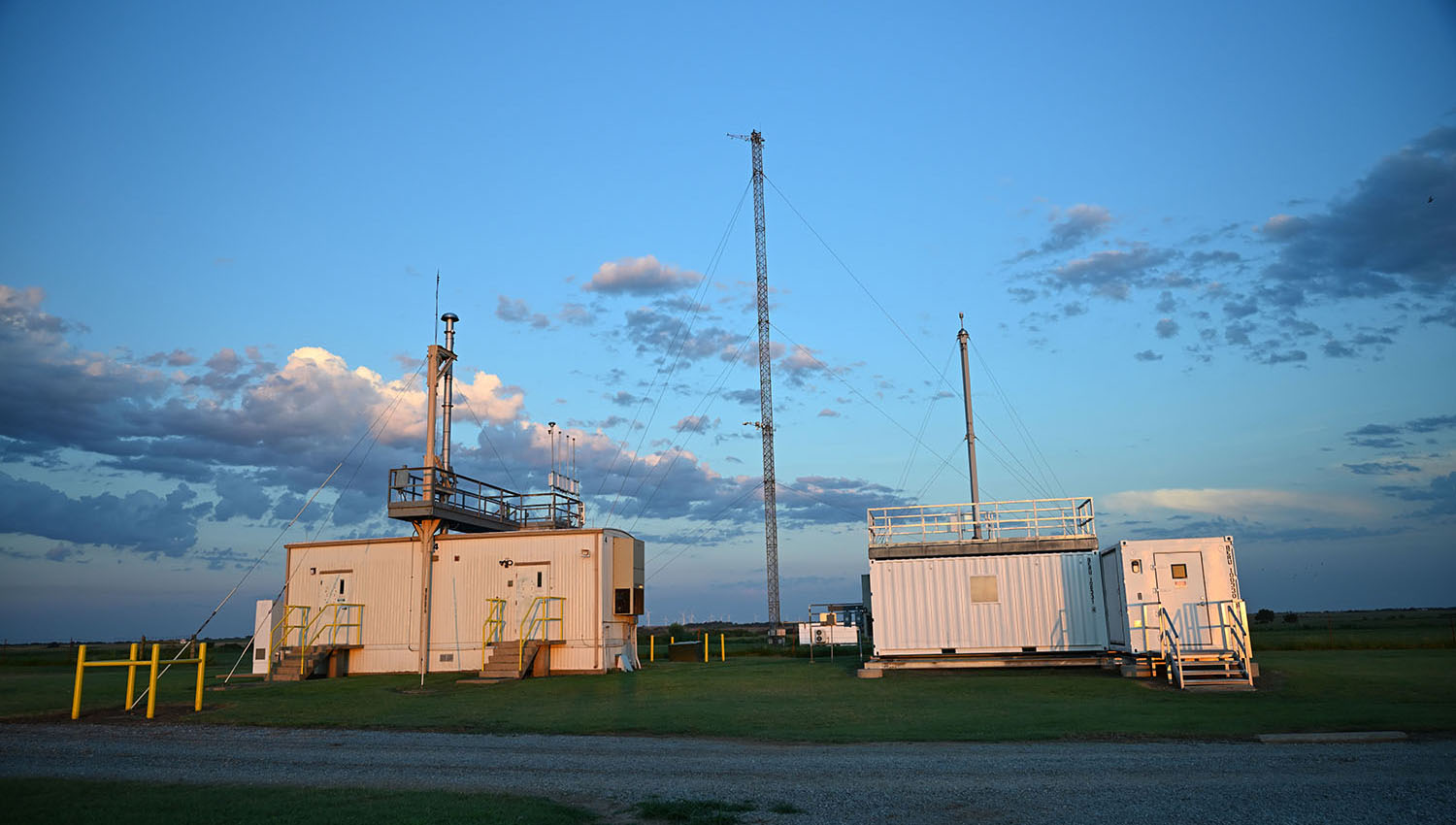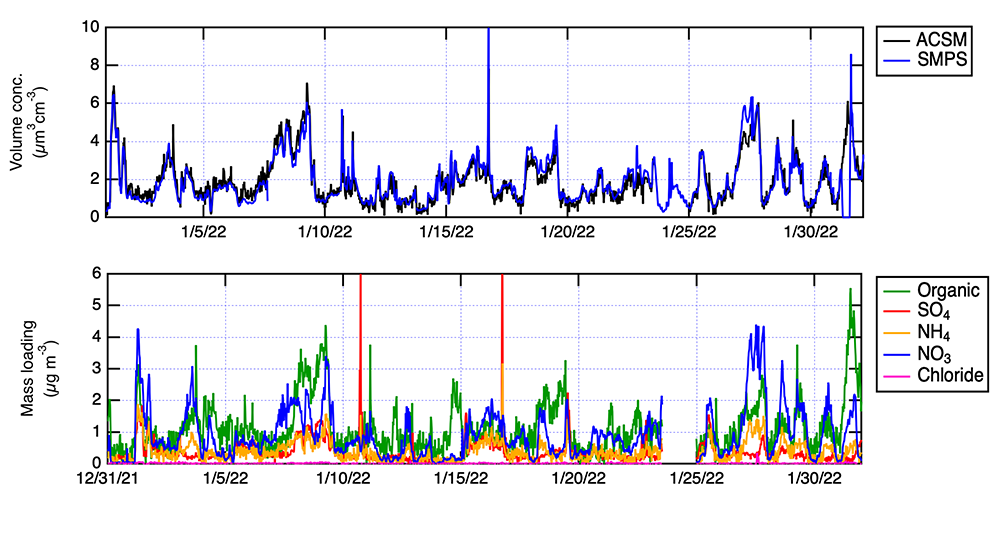ARM Instruments and Data Products Update: Aerosol Advancements
Published: 18 May 2022
Editor’s note: This is an update from ARM Engineering and Process Manager Jennifer Comstock, who also oversees ARM science products.

Aerosol processes play an important role in the Earth’s radiative energy budget, which continues to be a source of uncertainty in climate model simulations. ARM measurements and data products of aerosol chemical, microphysical, and optical properties enable scientists to better understand aerosol formation and evolution, and their direct and indirect effects on the radiative energy budget.
In fiscal year 2021 (FY2021), ARM made several improvements to its Aerosol Observing System instruments.
ARM procured three optical particle counters (OPCs). One is at the Southern Great Plains (SGP) atmospheric observatory, and the other two are operating as part of the TRacking Aerosol Convection interactions ExpeRiment (TRACER) and Surface Atmosphere Integrated Field Laboratory (SAIL) campaign.
The OPC measures aerosol particle size distribution between 0.253 and 35.15 µm, extending the measured size distribution range to include coarse-mode particles, such as sea salt and dust. ARM aerosol instrument mentors Chongai Kuang and Ashish Singh are evaluating the OPC’s performance in the lab and in the field through comparisons with the aerodynamic particle sizer, which measures a similar size range using an aerodynamic sizing technique.

ARM also purchased an additional scanning mobility particle sizer (SMPS) for deployment with the ARM Mobile Facilities. This instrument measures aerosol concentration and aerosol particle size distribution. The new SMPS is currently deployed to SAIL and will be part of the upcoming mobile facility deployment in the Southeastern United States.
In FY2022, an additional SMPS will be purchased and deployed to the Eastern North Atlantic (ENA) observatory.
In addition, ARM procured a new time-of-flight aerosol chemical speciation monitor (TOF-ACSM) to support the SAIL campaign. The TOF-ACSM provides continuous online measurements of ambient aerosol mass concentrations and composition for particulate ammonium, nitrate, sulfate, chloride, and organic species. These measurements help identify the source and chemical composition of atmospheric particulates.
Data Products
Aerosol translator John Shilling is leading the development of several new value-added products (VAPs) to help support ARM’s new and existing Aerosol Observing System instruments.
Cloud condensation nuclei (CCN) counters measure the number concentration of aerosol particles that can form cloud droplets in humidified air. In one ARM VAP, CCN concentration is combined with size distribution measurements from the SMPS to derive the hygroscopicity parameter (kappa). This parameter quantifies the ability of a particle to activate, condense water vapor, and form a cloud droplet. The CCNSMPSKAPPA VAP is available for the SGP and the Layered Atlantic Smoke Interactions with Clouds (LASIC) and Cloud, Aerosol, and Complex Terrain Interactions (CACTI) campaigns.
CCNSMPSKAPPA is being expanded to include measurements from the Cold-Air Outbreaks in the Marine Boundary Layer Experiment (COMBLE) and the Multidisciplinary Drifting Observatory for the Study of Arctic Climate (MOSAiC) expedition. Initial data from TRACER and SAIL are being processed and reviewed. We expect that these data will be available by the end of 2022.
CCN concentration at cloud base is a key measurement for understanding cloud formation. Combining surface-based CCN measurements with lidar extinction profiles provides an estimate of vertical profiles of CCN concentration up to cloud base. ARM released an updated version of the CCN Profile (CCNPROF) VAP, called Retrieved Number concentration of CCN (RNCCN), which better screens for poor-quality input data. The updated VAP’s algorithm has been evaluated using aircraft measurements, and nine months of RNCCN data are available for the SGP.

Lastly, major updates to ACSM data have been made to provide b- and c-level data sets for users through collaboration between Shilling and ACSM mentor Maria Zawadowicz.
The b-level data sets include additional data quality checks and processing to provide a more robust product than the a-level ingest.
Two types of c-level data products are available. The c1-level product runs in near-real time and uses an autonomous algorithm to correct for composition-dependent collection efficiency (CDCE), whereas the b-level product assumes a collection efficiency of unity. (Collection efficiency is the fraction of ambient particles detected by the ACSM.) The c2-level product also incorporates the CDCE correction, but it is processed periodically by the instrument mentor. ARM recommends using the highest c-level data product—i.e., c2 over c1—when available.
ACSMCDCE data are now available for the SGP, ENA, LASIC, CACTI, and TRACER. In FY2022, ARM is working to expand the CDCE processing to TOF-ACSM measurements.
Aerosol Measurements Strategy—Looking Ahead
Many of ARM’s original aerosol instruments are reaching their end of life. As new technologies become available, aerosol mentors are actively evaluating potential improvements.
The particle soot absorption photometer and the three-wavelength nephelometer, instruments that provide measurements of optical properties, need replacement. In FY2022, ARM is procuring and evaluating potential replacements for these systems.
More broadly, ARM will work with the Aerosol Measurement Science Group and the aerosol community to develop measurement strategies for its ENA and North Slope of Alaska observatories to determine gaps in ARM’s current strategy.
Look for a blog coming soon on products for modelers. All ARM data are freely available to download and order from Data Discovery.
Keep up with the Atmospheric Observer
Updates on ARM news, events, and opportunities delivered to your inbox
ARM User Profile
ARM welcomes users from all institutions and nations. A free ARM user account is needed to access ARM data.


















